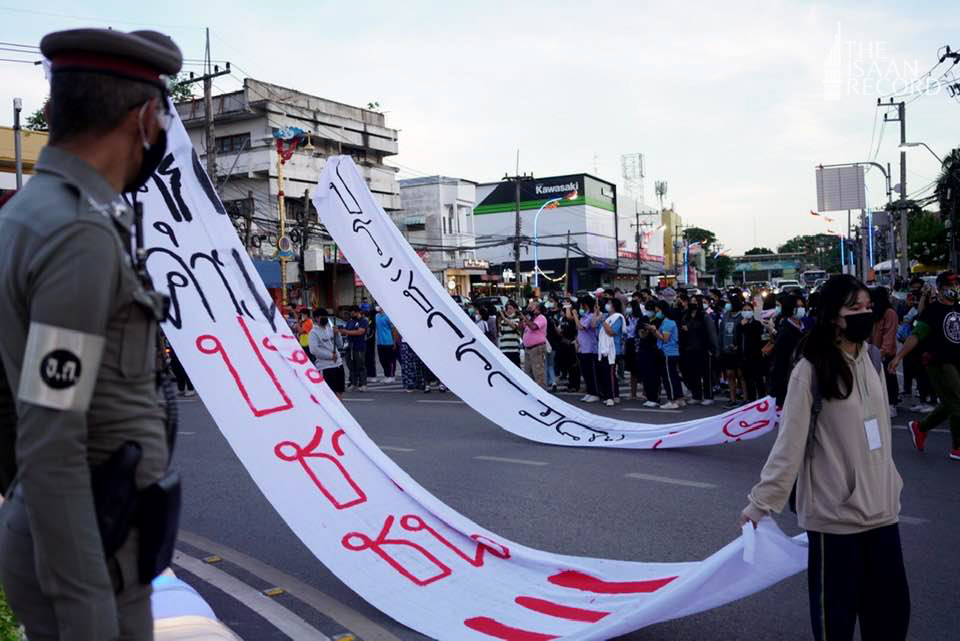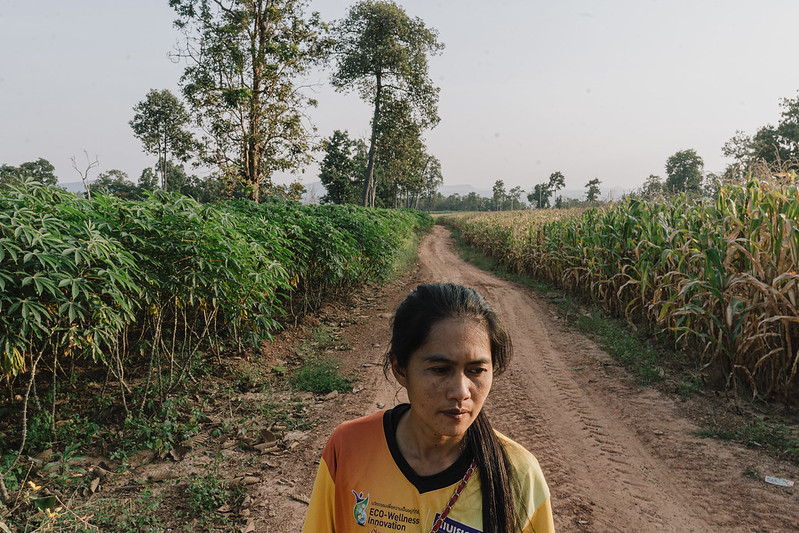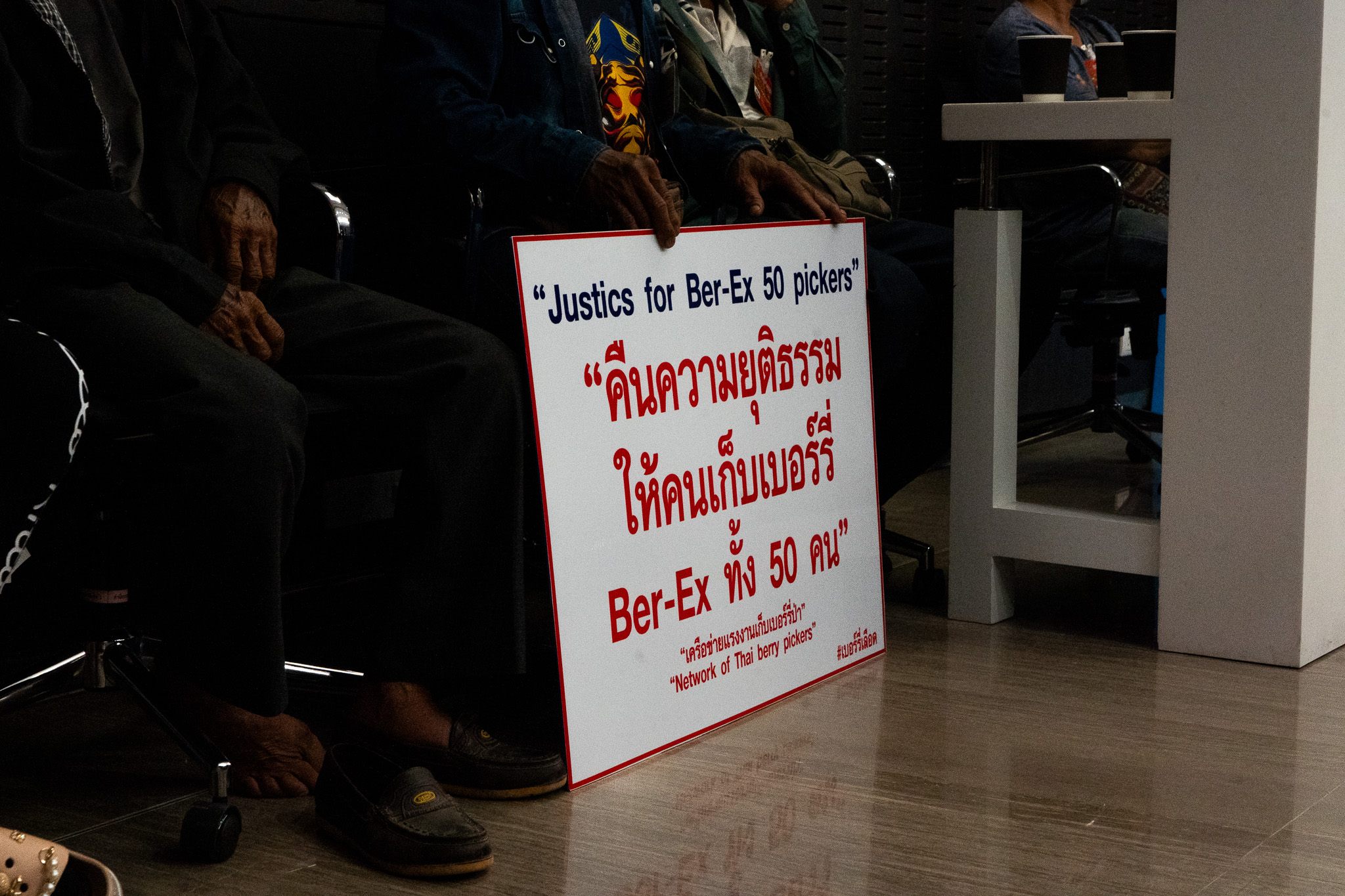
By David Streckfuss
The first battle was over royal portraits, or more exactly, what royal portraits might witness.
When representatives of the protesters notified the police that they were not only going to hold a protest but were also going to march, hard negotiations began.
At first, the police claimed that a march would disrupt the “strategic economic points of transportation of the city” and if the procession reached the three key roundabouts in the heart of the city, it would “cause trouble.”
The representatives insisted they would march.
As negotiations wore on, the police revealed their “special” worry: that marchers would pass royal portraits along their route, and they would make the three-finger salute within sight, so to speak, of the portraits
“They tried to admonish us, that if we happened to pass the royal portraits and gave the three-finger salute,”says Pachara “Max” Sarntiyakul, 23, one of the representatives talking to police that day. But “we ourselves were not sure that there just might be too much of a display of three-finger salutes,” or something worse. What if the protesters gestured in some impolite, rude way, a way that the police said might be “unclean?”

Source: Google Map Street View, Udon Thani Clock Tower Roundabout
Still, they insisted they were going to protest.
The police became more solicitous. According to Max, the authorities then asked, “Can you not talk about the royals?” Max said he could agree but he was just one person. He told the police there would be an open mic.
“We can’t shut the mouths of others,” he told the police who then implored them, “Well, if you do speak about the royalty, can you speak reasonably, speak according to the facts, and not speak in a threatening or scolding manner or say anything that is not the truth?”
Almost begging, the police negotiators pleaded, “Can you just not speak of it, or if you do, just speak about the royals very little?’”
“They were very afraid of us raising the three-finger salute before the royal portrait,” says Max. “They were afraid of the protest march. But we insisted that we were going to march.”
So the police changed tack. They said that if the protesters called off their planned march and just stayed put, Max says,
“they would arrange everything for us—a mobile toilet truck, lights, speakers—they’d give us everything.”
But Max says, “We are bad students. We are stubborn children.We were most certainly going to march, and we were going to make the processions as long as it could be.”
The protest came off a day or two later. The defeated police pledged they would “facilitate every convenience” for the protesters but made sure they could remove any royal portrait that might have witnessed the march.
Thankfully for the police, the protesters refrained from raising the three-finger salute while passing the Clock Tower Roundabout with the royal portrait.
Udorn’s latest movement has come from high school students
The current protests and counter-protests in Thailand are replete with symbols. Earlier on, the new generation has adopted the disappeared plaque commemorating the 1932 overthrow of the absolute monarchy, and then poked fun at symbols as a whole by theming their protests, starting with Harry Potter and more recently, without any clear explanation, adopted yellow rubber ducks.
Much less inventively, the ultra-conservatives have donned yellow shirts and held up portraits of past and present kings.
The protests in Udon Thani have in a sense been a battle over symbols, a battle between one generation who limps in on nostalgia and a generation who has “had their eyes opened” .
Just as campuses around the country, a flash protest had appeared at Udon Thani Rajabhat University after the dissolution of the Future Forward Party in late February. Max understood that the university had clamped down hard on the organizers who were also threatened by the police. By the time that a new round of student protests started in June, Rajabhat administrators applied pressure to keep students quiet and away from any protests.
The first stirrings of protest in the province after COVID-19 restrictions came from the high schools. Mudmee (a code nickname) is a well-spoken 16-year-old who studies at Satri Rachinuthit School in Udon.
She describes her journey, one that started with self-discovery through social media, particularly the website, Royalist Marketplace, months before any protests began. Mudmee was “wowed” by what she learned on this “amazing” website. She was “amazed how I’d been propagandized for all of my 16 years.” She’d “seen the light” [the phrase used by red shirts in the past], “just by this one single link.”

“I just ‘had my eyes opened.’ That means I’ve just seen the truth of all things within less than a year. And so I’ve come out. Once we knew the truth, it was like, ‘Oh! We’ve been subject to your propaganda all along. You’ve been deceiving us.’ We felt like, ‘Why have you been acting like this toward us?’ So I came out and started making demands.”
Her first target was what was closest to her: the education system. “Thai children should receive better educational material than this. But what we’re getting is I don’t know what. The system of learning and teaching in schools, the Thai education system, is terrible.”
It was around the anniversary of the overthrow of the absolute monarchy that Mudmee put her growing awareness into action. She’d been looking around Udon for a suitable place to make a statement. “One day,” she said, “I had the idea that I ought to hold up a sign demanding the government see the problems were were facing.”
So she got five or six of her schoolmates together and they started holding up a sign for two days in June. Soon, some students from other schools joined her as well as members of the public. She and her classmates started to look at problems in their school. They decided to set up the R.N. Revolution group to address issues in the school and outside the school.
The school begrudgingly allowed students to carry out activities in the school but also sometimes tried to obstruct activities, such as when an unannounced fumigation of the school grounds for mosquitoes was announced at the time one of the group’s activities was to be held.
But students in another high school were beginning to stir. “Mingkhwan” is a 15-year-old tenth grader at a noted high school in the province. She got involved because at first because she started to see “the disparities” in her school which she says are part of a “mostly broken” system. She also started thinking about the larger problems in Udon: why was the transportation system so bad? Why hasn’t there been more development than this even when we’ve paid taxes?

Photo by Donlawat Sunsuk/The Isaan Record
Udon Thani city itself, protesters say, are very “slim,” a term denoting middle-class urbanites who support the ultraconservative government and monarchy. As the youth movement has grown, conflicts within many families have erupted.
As Mingkhwan she was asking more questions and becoming more politically active, her parents became worried. Although they didn’t forbid her from protesting, they did want her to stay safe, and they worried about what might happen to the family. They told her, “Think about others. Seriously think about people in your family.”
But she’s stayed involved while keeping her grades up at a school that is typically rated as the top one or two high schools in Isaan. She’s proud to be part of the leadership team and “very proud that I have played a part in thinking there needs to be changes.”
The second battle over symbols: a monument
The Krom Luang Prajak Sillapakhom Monument is in the center of the city’s most central roundabouts. Over the past few decades, it is where the city celebrates its cityhood on January 18 every year.

Source: Thailand Tourism Directory
An Udon province tourist publication gives the monument top ranking, saying that it lists the monument as its no. 1 tourist attraction, the monument “symbolizes the highest tribute paid to the prince by the people of Udon Thani.”
A government tourist site informs Thai tourists about the “distinctive feature” of the monument that “well-informed persons” tell of the “secret” of getting their blessings met. One is to “diligently pray” to [sacred] Him”to succeed in school exams, promotions, military and police exams, career advancement, and removal of obstacles by “running around the statue and give an offering of a horse and sword” (presumably a small representation of each is meant, and not an actual horse and full-length sword).
The site describes it as “one of the most revered, important, city-defining sacred things.”
The monument has become less a place to commemorate than a sacred shrine, a place of worship.
Given its centrality both geographically and spiritually, it is inevitable that both celebrations and protests find their way to Krom Luang Roundabout.
After using the space, a group is typically expected “to ask forgiveness of the monument for transgressing upon the space.
Youth protesters, who have found themselves at the monument a number of times, refrained from doing so. Max says that some said, “Thai culture holds [the site] as sacred.”
But in the end, the protesters did not ask forgiveness. Chanon “Atom” Ardnarong was there. He’d joined a protest in June. The 18-year-old had been drawn to the policies and idealism of the Future Forward Party. In his last semester in high school, he had taken an elective course on constitutional law. It made him question everything. How could an elected government act so dictatorially? How could laws be used so unjustly? It opened his eyes, and he applied to join the group.
He says the clearest reason behind his coming out to protest was that “we could just no longer take it.” We “could no longer bear to see people in trouble, see more and more poor people, more and more homeless people.”
He felt that if he came out, he could be part of creating a better society where people had equal rights. He says he wanted to be “a voice of the majority, so they could access services of the state.”
He was there the night of the protest. Now thinking about that moment before the monument, he seems a little impatient with the question and says, “We didn’t ask for forgiveness because we say that the money for the monument’s upkeep is our money. It is our money that paid for building it. Why would we ask for forgiveness?”

Photo by Donlawat Sunsuk/The Isaan Record
Another protest leader, Karn (a code nickname), 21, says, “We considered the monument to be the people’s. This road is the people’s. We protest leaders are trying to forge a culture for everyone. We had an open mic and people came up and spoke. People came up and attacked the prime minister with relish and fierceness. More came and asked to speak because that mic was the people’s.”
Bangkok imposes its stamp
The response of youth protesters is instructive. They made the argument that everything public in Udon city came from their own taxes. But historically speaking, it wasn’t as if this member of the Bangkok-based Chakri family was ever watching over the fortunes of Udon Thani.
Krom Luang Prajak Silapakhom was born in Bangkok in 1856, a half-brother to King Chulalongkorn (1868-1910). He was appointed the royal commissioner of the Monthon Lao Phuan, an area covering the north part of Isaan and part of present-day Laos. His original headquarters was along the Mekong River. After Siam was required to pull troops 25 kilometers back from the river, Prajak set up the “North” province at Ban Dua Mak Khaeng (or Ban Mak Khaeng ) in 1893, which in the 1930s evolved into Udon Thani.
Prajak and his family fell out of favor of the Chakri court in 1910 and was banished from the court.
When in the Northeast, Prajak was essentially a viceroy, overseeing a colonial-style subjugation of Lao ethnic people. He returned to Bangkok after seven years in 1899, never to return. The memorial to Prajak was conceived more than seventy years later. King Rama IX presided over the statue’s unveiling in 1971, originally in a military base.
The statue was later moved to Thung Sri Muang Park and then again relocated to the Krom Luang roundabout in 1999.
So Prajak was hardly a long-standing personality (or spirit) in the lives of Udon Thani people. His memory was resurrected in the form of a statue during the Communist insurgency, as a way of tying the populace to Bangkok.
To whatever local spirits people in Udon had made supplications in the past, this more powerful royal Bangkok spirit edged them out and relegated them to irrelevance for 50 years.
While the youth demonstrators probably have a foggy notion of their city’s patron saint, they nonetheless insisted that they owed nothing special to it as any monuments had been paid for with their own money.
But, knowing or not, not asking for forgiveness was also a statement about the Bangkok-centered and dynastic focus of today’s Thailand. Whatever public spirits there might have been were usurped by a Bangkok one.
See tomorrow’s Part II of “Udon Thani’s new generation: Battle over royal portraits, a monument, and a flag.”




